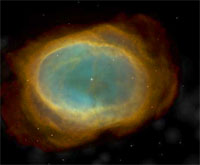This month we continue our tour of the Caldwell objects. The objects listed should be easily visible between the onset of darkness until at least 11 pm unless otherwise noted. Some objects will be low on the southern horizon. If you missed the February objects, most if not all can still be viewed. Info can be found here.
 Caldwell 39 (NGC 2392, the eskimo nebula) - [07h 29.2m, +20°55'] - C39 is a strikingly beautiful planetary nebula and one of the more famous Hubble images. This is a good object to observe through various filters (OIII, UHC) and using high magnification to attempt to see some of the structure within the object. On March 14, Comet Lulin will be within 17 a-m of C39 (photo op!).
Caldwell 39 (NGC 2392, the eskimo nebula) - [07h 29.2m, +20°55'] - C39 is a strikingly beautiful planetary nebula and one of the more famous Hubble images. This is a good object to observe through various filters (OIII, UHC) and using high magnification to attempt to see some of the structure within the object. On March 14, Comet Lulin will be within 17 a-m of C39 (photo op!).
Caldwell 7 (NGC 2403) - [07h 36.9m, +65°36'] - NGC 2403 is a large dim galaxy in Camelopardalis about 7.5 degrees SW of Muscida (in Ursa Major). Though listed at 8.4 magnitude, it's large size gives it a low surface brightness which makes this a tough object to find. You'll need a dark sky and good transparency.
Caldwell 25 (NGC 2419) - [07h 38.1m, +38°53'] - C25 is a small faint globular cluster in Lynx, about 7 degrees North of Castor. It's a dim little fuzzball that won't show much structure unless you bring out your yardscope.
Caldwell 71 (NGC 2477) - [07h 52.3m, -38°33'] - Here's the first low object of tonight's tour - a large, open cluster that will be at best around 15 degrees above the horizon. C71 is easy to find about 2.6 degrees WNW of Naos in the constellation Puppis. It's a dense cluster with several hundred stars. Best observing time in mid-March is around 9:30 pm (daylight savings time).
Caldwell 54 (NGC 2506) - [08h 00.2m, -10°47'] - C54 is an old cluster consisting of many red giants as well as some main sequence stars. It's of average size (7 a-m) and brightness (7.6) with a slightly triangular shape. Several arcs of bright stars are observed with perhaps 50 stars being visible through the eyepiece. The cluster is located about 5 degrees ENE of alpha-Monocerotis.
Caldwell 53 (NGC 3115, the spindle galaxy) - [10h 05.2m, -7°43'] - A bright, nearly edge-on lenticular galaxy approximately 32M l-y from Earth. C53 is estimated to be several times larger than our Milky Way Galaxy with a supermassive black hole at its core (2 billion solar masses). The bright (mag. 9.8) galaxy is easy to find - about 3 degrees East of γ-Sex (gamma-Sextantis).
 Caldwell 74 (NGC 3132, the eight burst nebula) - [10h 07.7m, -40°26'] - Get ready to get down and dirty (again). C74 is very low in the Southern sky never rising more than about 15 degrees above the (Upham) horizon. During March, it's best observed around 11 pm. It's plenty bright at mag. 9.4, and has a slighly ovoid shape. It's in Vela just over two degrees NW of mag 3.8 HIP50191 (one of the brighter stars in the constellation).
Caldwell 74 (NGC 3132, the eight burst nebula) - [10h 07.7m, -40°26'] - Get ready to get down and dirty (again). C74 is very low in the Southern sky never rising more than about 15 degrees above the (Upham) horizon. During March, it's best observed around 11 pm. It's plenty bright at mag. 9.4, and has a slighly ovoid shape. It's in Vela just over two degrees NW of mag 3.8 HIP50191 (one of the brighter stars in the constellation).
Caldwell 79 (NGC 3201) - [10h 17.6m, -46°25'] - While you're down on the ground, move your telescope 4ish degrees south of HIP50191 to a bright (mag 6.7) globular cluster. C79 is one of the crown jewels of the southern sky. It's bigger and brighter than M13. C79 is also somewhat unique in that the concentration of stars at its core is particularly low.

